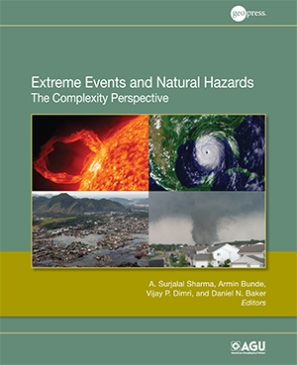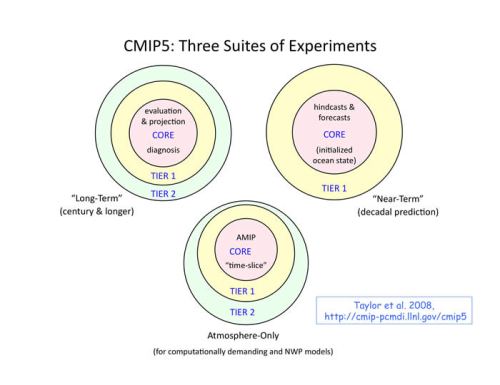
above figure from Caesar et al 2006
A new paper has appeared;
Donat, M. G. and L. V. Alexander (2012), The shifting probability distribution of global daytime and night-time temperatures, Geophys. Res. Lett., 39, L14707, doi:10.1029/2012GL052459.
The abstract reads [highlight added]
Using a global observational dataset of daily gridded maximum and minimum temperatures we investigate changes in the respective probability density functions of both variables using two 30-year periods; 1951–1980 and 1981–2010. The results indicate that the distributions of both daily maximum and minimum temperatures have significantly shifted towards higher values in the latter period compared to the earlier period in almost all regions, whereas changes in variance are spatially heterogeneous and mostly less significant. However asymmetry appears to have decreased but is altered in such a way that it has become skewed towards the hotter part of the distribution. Changes are greater for daily minimum (night-time) temperatures than for daily maximum (daytime) temperatures. As expected, these changes have had the greatest impact on the extremes of the distribution and we conclude that the distribution of global daily temperatures has indeed become “more extreme” since the middle of the 20th century.
This study, unfortunately, perpetuates the use of Global Historical Climate Reference Network surface temperature data as being a robust measure of surface temperature trends. The authors report that
We use HadGHCND [Caesar et al., 2006], a global gridded data set of observed near-surface daily minimum (Tmin) and maximum (Tmax) temperatures from weather stations, available from 1951 and updated to 2010. For this study, we consider daily Tmax and Tmin anomalies calculated with respect to the 1961 to 1990 daily climatological average.
As described in the paper
Caesar, J., L. Alexander, and R. Vose (2006), Large-scale changes in observed daily maximum and minimum temperatures: Creation and analysis of a new gridded data set, J. Geophys. Res., 111, D05101, doi:10.1029/2005JD006280.
A gridded land-only data set representing near-surface observations of daily maximum and minimum temperatures (HadGHCND) has been created to allow analysis of recent changes in climate extremes and for the evaluation of climate model simulations. Using a global data set of quality-controlled station observations compiled by the U.S. National Climatic Data Center (NCDC), daily anomalies were created relative to the 1961–1990 reference period for each contributing station. An angular distance weighting technique was used to interpolate these observed anomalies onto a 2.5° latitude by 3.75° longitude grid over the period from January 1946 to December 2000. We have used the data set to examine regional trends in time-varying percentiles. Data over consecutive 5 year periods were used to calculate percentiles which allow us to see how the distributions of daily maximum and minimum temperature have changed over time. Changes during the winter and spring periods are larger than in the other seasons, particularly with respect to increasing temperatures at the lower end of the maximum and minimum temperature distributions. Regional differences suggest that it is not possible to infer distributional changes from changes in the mean alone.
The Donat and Alexander 2012 article concludes with the text
Using the data from this study we conclude that daily temperatures (both daytime and night-time) have indeed become “more extreme” and that these changes are related to shifts in multiple aspects of the daily temperature distribution other than just changes in the mean. However evidence is less conclusive as to whether it has become “more variable”.
The Donat and Alexander (2012) paper and the Caesar et al (2006) paper, however, both suffer in their ignoring issues that have been raised regarding the robustness of the data they are using for their analyses. They either ignored or are unaware of papers that show that the conclusions they give cannot be considered accurate unless they can show that the unresolved uncertainties have either been corrected for, or shown not to affect their analyses. An overview of these issues is given in
Pielke Sr., R.A., C. Davey, D. Niyogi, S. Fall, J. Steinweg-Woods, K. Hubbard, X. Lin, M. Cai, Y.-K. Lim, H. Li, J. Nielsen-Gammon, K. Gallo, R. Hale, R. Mahmood, S. Foster, R.T. McNider, and P. Blanken, 2007: Unresolved issues with the assessment of multi-decadal global land surface temperature trends. J. Geophys. Res., 112, D24S08, doi:10.1029/2006JD008229.
which the authors ignored in their study. The questions the authors did not examine before accepting the robustness of their analyses include:
1. The quality of station siting in the HadGHCND and whether this affects the extreme surface temperatures [Pielke et al 2002; Mahmood et al 2006; Fall et al 2011; Martinez et al 2012].
2. The effect of a concurrent change over time in the dew point temperatures at each HadGHCND location, which, if they are lower, could result in higher dry bulb temperatures [Davey et al 2006; Fall et al 2010; Peterson et al 2011 ]
3. A bias in the siting of the HadGHCND observing sites for particular landscape types [Montandon et al 2011]
4. Small scale vegetation effects on maximum and minimum temperatures observed at HadGHCND sites [Hanamean et al 2003]
5. The uncertainty associated with each separate step in the HadGHCND homogenization method to develop grid area averages [Pielke 2005].
6. The warm bias that is expected to be in the HadGHCND with respect to minimum temperatures [which would be expected to be even more pronounced with respect to extreme cold temperatures] [Klotzbach et al 2010,2011; McNider et al 2012].
As just one example from the above list, Mahmood et al 2006 finds that
…the difference in average extreme monthly minimum temperatures can be as high as 3.6 °C between nearby stations, largely owing to the differences in instrument exposures.’
Note also in the figure at the top of this post, the poor spatial sampling for large portions of land.
The conclusion is that the HadGHCND data set is NOT sufficiently quality controlled, despite the assumption of the authors to the contrary. Ignoring peer reviewed papers that raise issues with their methodology does not follow the scientific method.
The complete cite for these peer-reviewed papers that were ignored are listed below:
Davey, C.A., R.A. Pielke Sr., and K.P. Gallo, 2006: Differences between near-surface equivalent temperature and temperature trends for the eastern United States – Equivalent temperature as an alternative measure of heat content. Global and Planetary Change, 54, 19–32.
Fall, S., N. Diffenbaugh, D. Niyogi, R.A. Pielke Sr., and G. Rochon, 2010: Temperature and equivalent temperature over the United States (1979 – 2005). Int. J. Climatol., DOI: 10.1002/joc.2094.
Fall, S., A. Watts, J. Nielsen-Gammon, E. Jones, D. Niyogi, J. Christy, and R.A. Pielke Sr., 2011: Analysis of the impacts of station exposure on the U.S. Historical Climatology Network temperatures and temperature trends. J. Geophys. Res., 116, D14120, doi:10.1029/2010JD015146.Copyright (2011) American Geophysical Union.
Hanamean, J.R. Jr., R.A. Pielke Sr., C.L. Castro, D.S. Ojima, B.C. Reed, and Z. Gao, 2003: Vegetation impacts on maximum and minimum temperatures in northeast Colorado. Meteorological Applications, 10, 203-215.
Klotzbach, P.J., R.A. Pielke Sr., R.A. Pielke Jr., J.R. Christy, and R.T. McNider, 2009: An alternative explanation for differential temperature trends at the surface and in the lower troposphere. J. Geophys. Res., 114, D21102, doi:10.1029/2009JD011841.
Klotzbach, P.J., R.A. Pielke Sr., R.A. Pielke Jr., J.R. Christy, and R.T. McNider, 2010: Correction to: “An alternative explanation for differential temperature trends at the surface and in the lower troposphere. J. Geophys. Res., 114, D21102, doi:10.1029/2009JD011841″, J. Geophys. Res., 115, D1, doi:10.1029/2009JD013655
Mahmood, R., S. A. Foster, and D. Logan (2006a), The geoprofile metadata, exposure of instruments, and measurement bias in climatic record revisited, Int. J. Climatol., 26, 1091–1124.
Martinez, C.J., Maleski, J.J., Miller, M.F, 2012: Trends in precipitation and temperature in Florida, USA. Journal of Hydrology. volume 452-453, issue , year 2012, pp. 259 – 281
McNider, R.T., G.J. Steeneveld, B. Holtslag, R. Pielke Sr, S. Mackaro, A. Pour Biazar, J.T. Walters, U.S. Nair, and J.R. Christy, 2012: Response and sensitivity of the nocturnal boundary layer over land to added longwave radiative forcing. J. Geophys. Res., doi:10.1029/2012JD017578, in press.
Montandon, L.M., S. Fall, R.A. Pielke Sr., and D. Niyogi, 2011: Distribution of landscape types in the Global Historical Climatology Network. Earth Interactions, 15:6, doi: 10.1175/2010EI371
Peterson, T. C., K. M. Willett, and P. W. Thorne (2011), Observed changes in surface atmospheric energy over land, Geophys. Res. Lett., 38, L16707, doi:10.1029/2011GL048442
Pielke Sr., R.A., T. Stohlgren, L. Schell, W. Parton, N. Doesken, K. Redmond, J. Moeny, T. McKee, and T.G.F. Kittel, 2002: Problems in evaluating regional and local trends in temperature: An example from eastern Colorado, USA. Int. J. Climatol., 22, 421-434.
Pielke Sr., Roger A., 2005: Public Comment on CCSP Report “Temperature Trends in the Lower Atmosphere: Steps for Understanding and Reconciling Differences“. 88 pp including appendices.
The Donat and Alexander (2012) is particularly at fault in this neglect as most of the papers questioning the robustness of the GHCN type data sets were published well before their article was completed. The conclusions of the Donat and Alexander study should not be considered as robust until they address the issues we raised in our papers.




![Visual04[1]](https://wattsupwiththat.files.wordpress.com/2012/09/visual041.jpeg?w=461&h=285)





